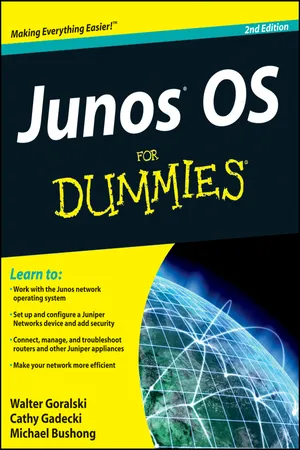Part I
Discovering Junos OS
In this part . . .
You know that nuclear reactor thingy that Robert Downey in the Iron Man movie put in this chest to power his rocket books and extraordinary powers? Well, that’s what Junos is to Juniper Networks devices.
This part introduces the Junos OS that is used for switching, routing, MPLS, and security. It also includes a section on migrating from other platforms. You find out all about Junos and how you can power your network at speeds way past the sound barrier.
Chapter 1
Junos Is Everywhere You Need to Be
In This Chapter
Understanding the functions of a network operating system
Discovering how Junos OS is different
Looking beyond the operating system to the Junos Platform
The Junos operating system (Junos OS) is the software that runs networking and security devices from Juniper Networks. Administrators use Junos OS to set up devices and connect them together in a network, and dictate how the devices move, service, and secure traffic across the network. They also use it to monitor and, when necessary, restore the network.
Note: In this book, we use both Junos OS and Junos as one and the same.
This chapter introduces Junos OS by describing the functions of a network operating system and then discussing how they work in Junos. The chapter also explores key differences in how Juniper develops Junos software versus how other vendors create their network operating systems, and introduces additional components of the Junos portfolio.
Functions of a Network OS
Networks consist of specialized devices that pass along traffic from one to another. Each device must know what to do with each arriving bundle of traffic, or packet, so that the packet can continue its journey to its destination. The devices perform three primary functions to process each packet:
Controls where the device sends the packets.
Applies services such as prioritization or security.
Forwards the packet to the next connecting device.
These actions are the primary functions of the network operating system that runs on the device. In simplest terms, the control plane of the network operating system is the brain of the device with the forwarding plane providing the brawn to quickly move packets through the system. Depending on the type of packet, the services plane may also provide packet services such as address translation, prioritization, and security.
Control functions
This essential map for connectivity, security, and other orchestrating processes is the function of the network operating system’s control plane. The processes and information of the control plane must provide answers to two essential questions:
How does the network direct the delivery of packets from one place to another? In other words, what are the routes or paths to establish, how do they change, and how does each device know which route to use for each packet?
What does the network do with each of the packets along its journey? In other words, what are the handling rules, or policies, along with the security and services plane established for traffic delivery?
Although the questions can be simply stated, the possible responses are virtually limitless. You can define dozens and dozens of protocols to answer these questions for different types of network maps and all the different types of traffic, not to mention how the control plane monitors and manages everything. The many processes to control the network delivery of packets fill the industry with all those three- and four-letter acronyms that you’ve somehow managed to file into your memory.
Service functions
The service needs of users grow with new applications triggering new requirements for quality, security, addressing, and content delivery, among others. Applying the specialized processing is the role of the services plane.
For example, as the packets flow through each device, the devices must typically apply a range of filters, policies, and services for protecting the network (and its clients and applications) and assigning priorities for the use of its resources. Visualize watching a YouTube video. Now visualize all your users watching the video all at the same time because some clown in your office passed along an e-mail with the link to everyone. And now think about all the traffic hitting your network all at once, just as your president is on a critical call with your biggest customer. Oofta!
This is just one example of where you may want to define a few of those extra rules that your network can follow in making its packet deliveries. (We provide Chapter 15 to help you set up class of service in your devices.)
Forwarding f...










